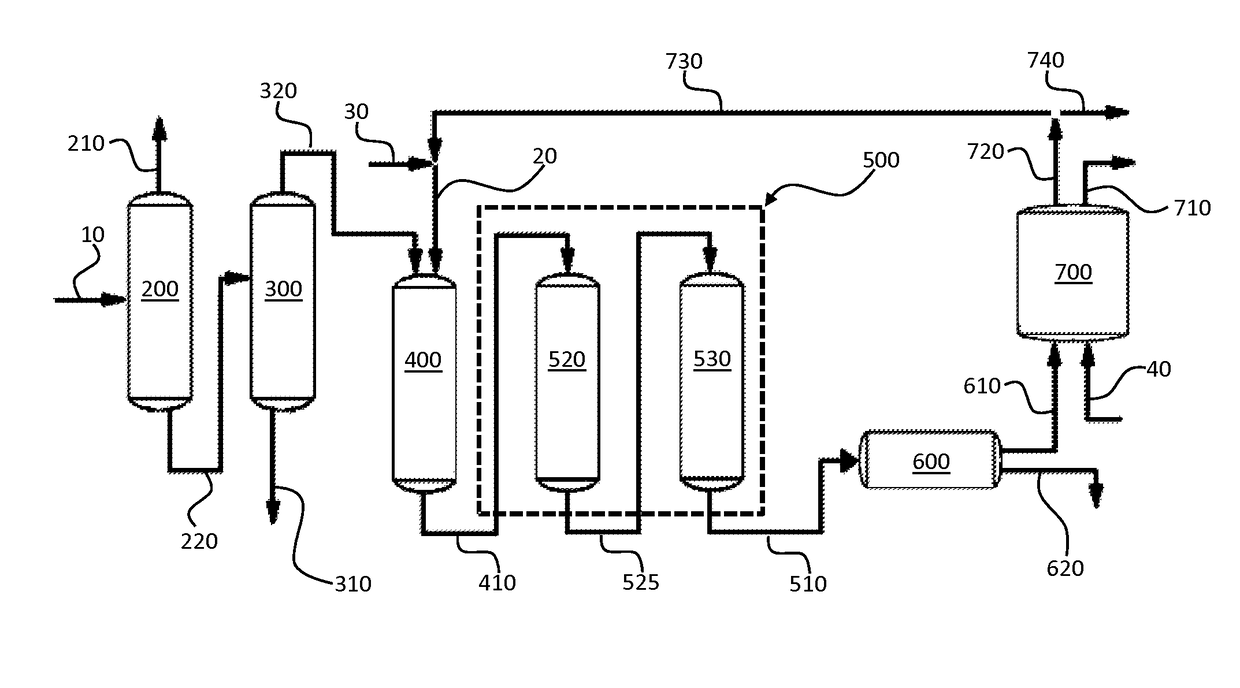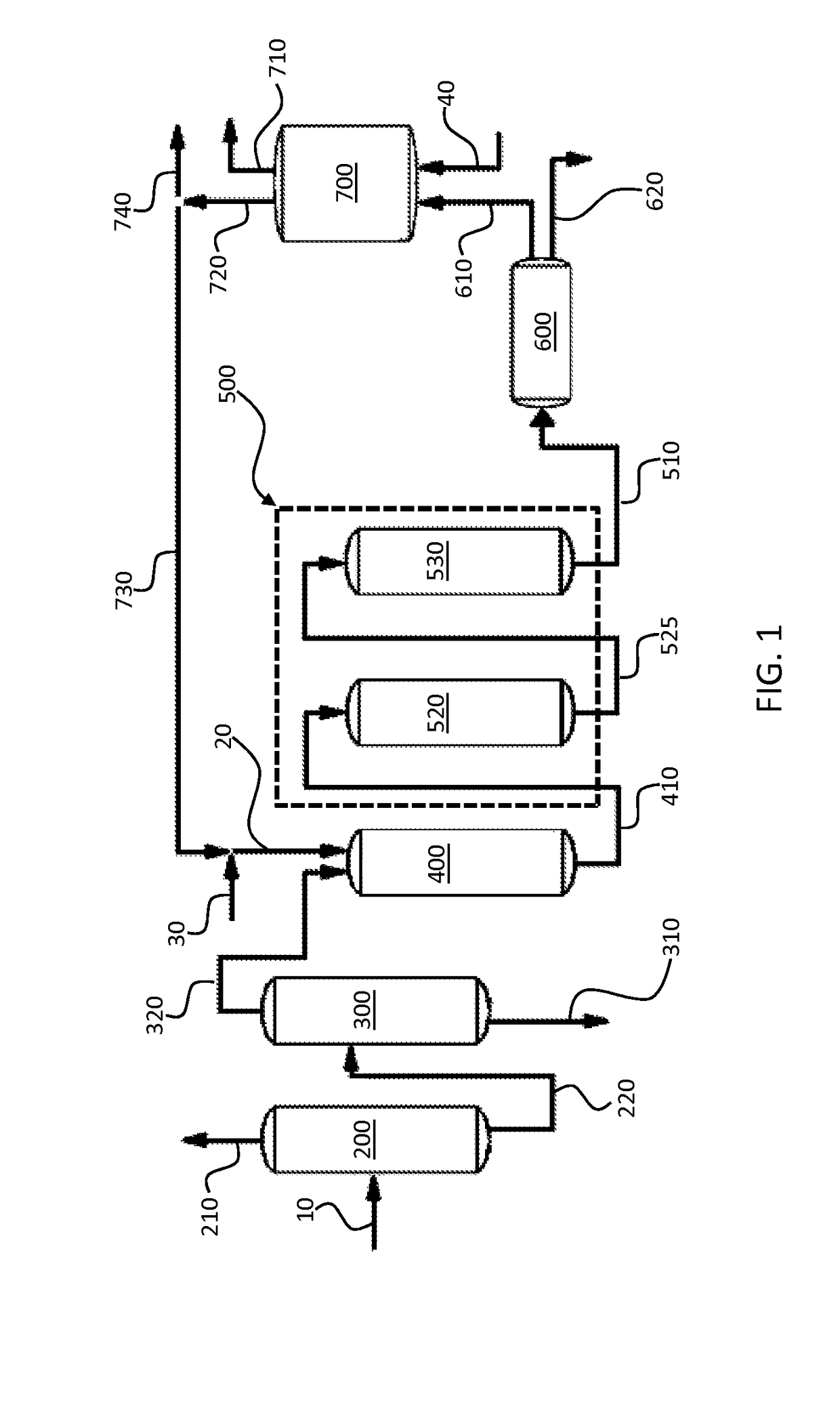Refining used motor oil through successive hydrotreating processes
a technology of hydrotreating process and used motor oil, which is applied in the direction of hydrocarbon distillation, vacuum distillation, lubricating oil distillation, etc., can solve the problems of process fallout and large majority of used oil is improperly disposed, and achieve the effect of improving the economic efficiency of the process
- Summary
- Abstract
- Description
- Claims
- Application Information
AI Technical Summary
Benefits of technology
Problems solved by technology
Method used
Image
Examples
example 1
[0024]A gasoil having the elemental composition and metal impurity contents listed below in Tables 1 and 2, respectively, were hydrotreated in four reactors operated in series.
[0025]
TABLE 1ElementCHNOSConcentration85.3 wt. %14.2 wt. % 0.1 wt. %0.6 wt. %980 ppm
[0026]
TABLE 2ElementCaMgNaSiZnPBConc. (ppm)0.50.20.8170.43010
[0027]The first reactor was packed with commercially available pre-sulfided Co—Mo catalyst supported on alumina and operated at a temperature of 308° C. The second reactor was also packed with commercially available pre-sulfided Co—Mo catalyst supported on alumina and operated at a temperature of 303° C. temperature. The third reactor was loaded with commercially available pre-sulfided Ni—Mo catalyst supported on alumina and operated at a temperature of 301° C. The fourth and last reactor was loaded with commercially available pre-sulfided Ni—Mo catalyst supported on alumina and operated at a temperature of 299° C. The oil was hydrotreated at approximately 1,200 psig ...
example 2
[0034]A gasoil having the elemental composition and metal impurity contents listed below in Tables 5 and 6, respectively, were hydrotreated in three reactors operated in series.
[0035]
TABLE 5ElementCHNOSConcentration85.6 wt. %14.4 wt. %0.2 wt. %0.4 wt. %900 ppm
[0036]
TABLE 6ElementCaMgNaSiZnPConc. (ppm)100.44844
[0037]The first reactor was packed with commercially available pre-sulfided Ni—Mo catalyst and operated at a temperature of 235° C. The second reactor was also packed with commercially available pre-sulfided Ni—Mo catalyst and operated at a temperature of 257° C. temperature. The third and last reactor was loaded with commercially available pre-sulfided Co—Mo catalyst and operated at a temperature of 312° C. The gasoil was hydrotreated at approximately 1,175 psig pressure with 5865 standard m3 per m3 of oil of an impure recycled hydrogen stream combined with 18 standard m3 per m3 of oil of a fresh hydrogen stream. Because the recycled hydrogen stream contains less 100% hydrogen...
example 3
[0043]The gasoil hydrotreating process described in Example 2 was repeated using the same feed gasoil, same three reactors operated in series, and the same temperatures as in Example 2 in all three reactors. The flow rate of fresh hydrogen was increased to provide a ratio of fresh hydrogen flow rate to stoichiometric flow rate of hydrogen required for heteroatom removal of approximately 1.8. The oil was hydrotreated at approximately 1,175 psig pressure with 5865 standard m3 per m3 of oil of an impure recycled hydrogen stream combined with 27 standard m3 per m3 of oil of a fresh hydrogen stream. Because the recycled hydrogen stream contains less 100% hydrogen, the total hydrogen flow rate is less than the combined total flow rate of 5892 m3. The ratio of fresh hydrogen flow rate to stoichiometric flow rate of hydrogen required to remove sulfur, nitrogen and oxygen compounds was approximately 1.77. The gasoil feed rate was such that it provided a LHSV of approximately 0.8 hr-1. After ...
PUM
| Property | Measurement | Unit |
|---|---|---|
| temperature | aaaaa | aaaaa |
| temperature | aaaaa | aaaaa |
| temperature | aaaaa | aaaaa |
Abstract
Description
Claims
Application Information
 Login to View More
Login to View More - R&D
- Intellectual Property
- Life Sciences
- Materials
- Tech Scout
- Unparalleled Data Quality
- Higher Quality Content
- 60% Fewer Hallucinations
Browse by: Latest US Patents, China's latest patents, Technical Efficacy Thesaurus, Application Domain, Technology Topic, Popular Technical Reports.
© 2025 PatSnap. All rights reserved.Legal|Privacy policy|Modern Slavery Act Transparency Statement|Sitemap|About US| Contact US: help@patsnap.com



